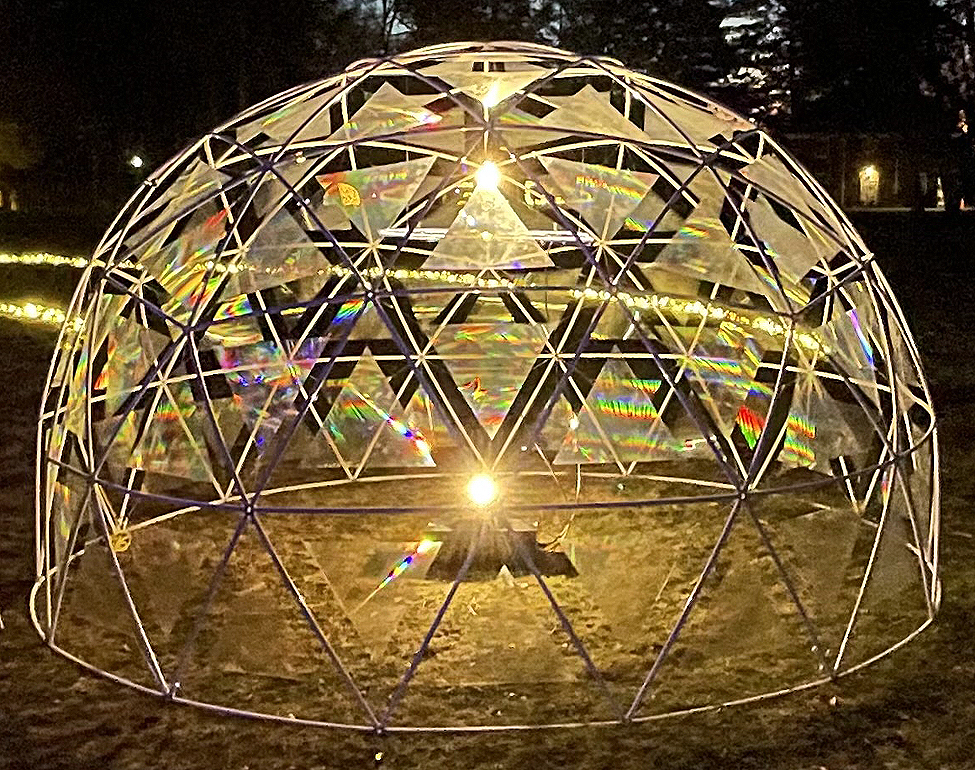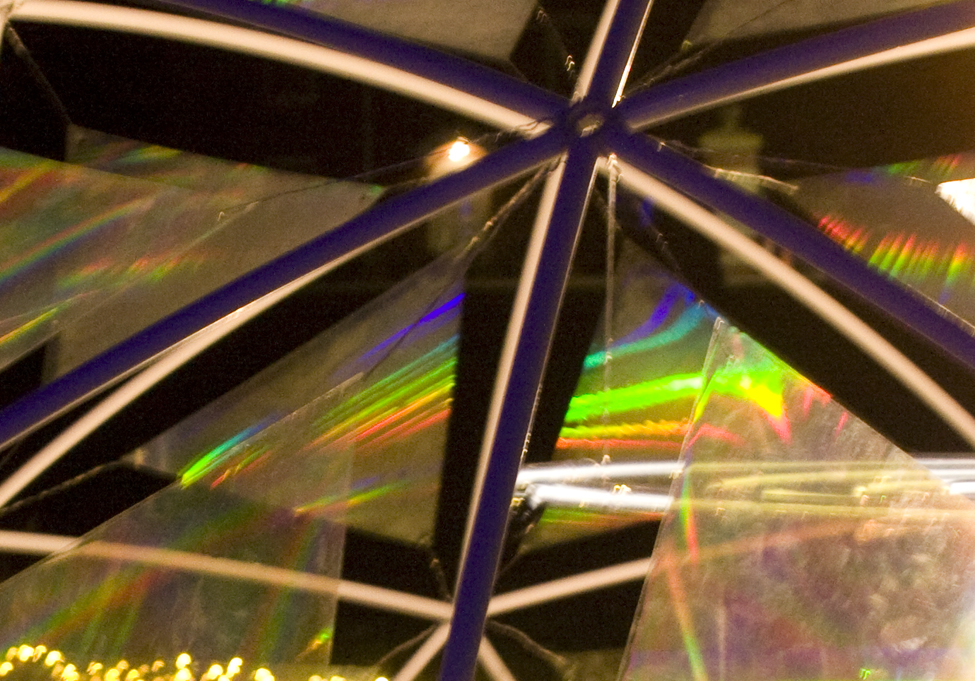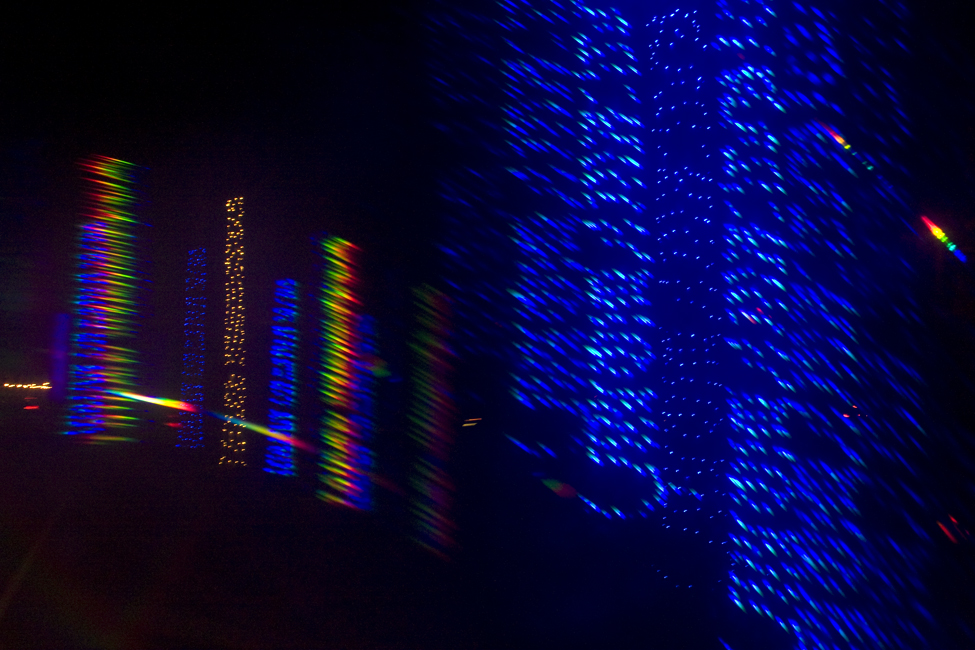
The Spectral Igloo is a light sculpture built by Chicago Artists John E. Bannon and Ed Wesly, and installed at Allerton Park in Monticello, Illinois as part of its Holiday GLOW Experience. A Garden Igloo Model V2 was decked out with Holographic Optical Embellishments, or HOE's for short. These pieces of film act like a combination of a prism and lens to transform light sources viewed through them into rainbow explosions of color floating in space.

Inside the dome, concentric circles filled with glowing white Krypton gas symbolize the essence of wave patterns, like the expanding ripples radiating from the point where a pebble had plopped into water. An incandescent bulb below the Xenon wave rings is the submerged seed of the source of the rings; the one above is poised to plop through the same spot.
John Bannon adjusts the top bulb and the Krypton-filled rings.

The wave motif for the glass gas tubes was selected because a simple way to describe a hologram is that it is a frozen light wave. The Basic Holographic Principle stores light waves not by halting them and capturing them in a jar but by photographically recording the interference pattern formed at the intersection of a pair of laser light waves.
When waves of a single wavelength in size collide, they generate an interference pattern in space, not unlike the classic model of visualizing interference patterns, the ripple tank experiment of high school physics. This fun toy utilized two linked bobbers as sources of expanding circles of water waves, each like a pebble dropped into a pond, but motorized to generate repetitive wavefronts in sync with each other.

There are areas where waves are moving on the surface of the water of the ripple tank, but there are well-defined areas where there is no wave activity thanks to the crest of one wave filling in the trough of the other. This is termed destructive interference; its complement being constructive interference, where crests from one bobber meet crests from the other to make taller waves and troughs of one meet up with the other's troughs to make deeper waves.
Light's wave-like nature is not physical, but a map of the state of its electric or magnetic field. The interference pattern of light waves is perceived by human eyes as areas of darkness where there is destructive interference, and bright areas where the waves interfere constructively. These are two amazingly hard to digest facts of light, that light on top of light can generate darkness, and that the interference pattern formed by two wavefronts traveling at the speed of light is stationary!
This bright and dark pattern when properly exposed and processed on holographic film can be translated into a pattern of ridges on the surface of the film, as in the micrograph of a section of a sample of a Spectral Igloo tile below, which looks amazingly similar to the action around the bobbers of the ripple tank and the Krypton sculpture! It's as if an instant-acting Jell-0 were added to the ripple tank to concretize the H2O!

In this photo taken in the holography laboratory of the Studio of E. Wesly & Sons we are looking at the back of a holographic plate that is being exposed to two blue laser beams. The small pencil like rays of light are shaped into cones of light that completely cover what will become the master hologram which will produce the over 100 copies needed to fill the spaces on the Igloo.

The pair of beams form an interference pattern in their intersected volume, and the hologram film placed there is exposed to the pattern of bright and dark fringes. This plate, suitably processed in chemistry not unlike that of traditional black & white photography, preserves the ripples on the electromagnetic pond as sculpted mounds of gelatin rising above the surface of the film sheet, which becomes the master matrix that acts like a printing plate in the replication lab.
Highly-skilled technicians in the clean room at the Studio of E. Wesly & Sons utilize a technique similar to sheet-fed print-making to replicate the holographic pattern of the master matrix in a layer of acrylamide on top of a sheet of polyester, a space age plastic known for its dimensional stability and ease of cleaning. Then the replicated HOEs are trimmed to size and installed wherever reality needs to be augmented.

It's a Feature Not a Bug Department: The size of the master hologram was 35 by 43 centimeters (14" X 17") which could be cut down to equilateral triangles 40 cm (16") on a side. But the vacancies to be filled on the geodesic dome were triangles 70 cm (28") on a side, so there was a blank border around each tile, which allowed the viewers to see the unadulterated light source at the same time as its holographically corrupted image.

In addition to enjoying the light show seemingly inside the igloo whilst standing outside of it, when standing inside the dome and looking out of it reality takes on another dimension, like the trunks entwined with Christmas tree lights at the Allerton Park GLOW Experience.

During daylight hours, sunlight passing through the HOE tiles focuses rainbows on the lawn.

Please visit johnebannon.com and eweslystudio.com and for more insights into the minds of the artists.
The artists can be reached at
eweslystudio@gmail.com (Ed Wesly)
and
jeb@johnebannon.com (John E. Bannon)
The Spectral Igloo prototype was erected and taste-tested at Sedgwick Studio Chicago, Illinois, before being installed at Allerton Park. Something similar can be set up in your own backyard if so desired, contact one of the artists above for details.